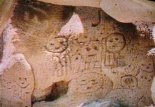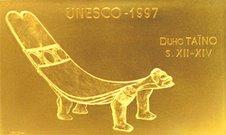
In this image released by Oregon State University, a lionfish swims off Lee Stocking Island, Bahamas in July, 2007. The lionfish, a vibrantly colored spiny and venomous predator from the western Pacific, is rapidly spreading in the Caribbean's warm waters, according to marine biologists who are studying the phenomenon. (AP Photo/Mark Albins/Oregon State University)
By DAVID McFADDEN, Associated Press Writer
SAN JUAN, Puerto Rico - A maroon-striped marauder with venomous spikes is rapidly multiplying in the Caribbean's warm waters, swallowing native species, stinging divers and generally wreaking havoc on an ecologically delicate region.
The red lionfish, a tropical native of the Indian and Pacific oceans that probably escaped from a Florida fish tank, is showing up everywhere — from the coasts of Cuba and Hispaniola to Little Cayman's pristine Bloody Bay Wall, one of the region's prime destinations for divers.
Wherever it appears, the adaptable predator corners fish and crustaceans up to half its size with its billowy fins and sucks them down in one violent gulp.
Research teams observed one lionfish eating 20 small fish in less than 30 minutes.
"This may very well become the most devastating marine invasion in history," said Mark Hixon, an Oregon State University marine ecology expert who compared lionfish to a plague of locusts. "There is probably no way to stop the invasion completely."
A white creature with maroon stripes, the red lionfish has the face of an alien and the ribbony look of something that survived a paper shredder — with poisonous spikes along its spine to ward off enemies.
The invasion is similar to that of other aquarium escapees such as walking catfish and caulerpa, a fast-growing form of algae known as "killer seaweed" for its ability to crowd out native plants. The catfish are now common in South Florida, where they threaten smaller fish in wetlands and fish farms.
In Africa, the Nile Perch rendered more than 200 fish species extinct when it was introduced into Lake Victoria. The World Conservation Union calls it one of the 100 worst alien species invasions.
"Those kinds of things happen repeatedly in fresh water," Hixon said. "But we've not seen such a large predatory invasion in the ocean before."
The lionfish so far has been concentrated in the Bahamas, where marine biologists are seeing it in every habitat: in shallow and deep reefs, off piers and beaches, and perhaps most worrisome, in mangrove thickets that are vital habitats for baby fish.
Some spots in the Bahamian archipelago between New Providence and the Berry Islands are reporting a tenfold increase in lionfish just during the last year.
Northern Caribbean islands have sounded the alarm, encouraging fishermen to capture lionfish and divers to report them for eradication.
The invasion would be "devastating" to fisheries and recreational diving if it reached Puerto Rico and the U.S. Virgin Islands, according to Eugenio Pineiro-Soler of the Caribbean Fishery Management Council.
"I think at the best they will have a huge impact on reef fish, and at the worst will result in the disappearance of most reef fish," said Bruce Purdy, a veteran dive operator who has helped the marine conservation group REEF with expeditions tracking the invasion.
Purdy said he has been stung several times while rounding up lionfish — once badly.
"It was so painful, it made me want to cut my own hand off," he said.
Researchers believe lionfish were introduced into the Atlantic in 1992, when Hurricane Andrew shattered a private aquarium and six of them spilled into Miami's Biscayne Bay, according to the National Oceanic and Atmospheric Administration.
Biologists think the fish released floating sacs of eggs that rode the Gulf Stream north along the U.S. coast, leading to colonization of deep reefs off North Carolina and Bermuda. Lionfish have even been spotted as far north as Rhode Island in summer months, NOAA said.
They are not aggressive toward humans, and their sting is not fatal. There are no estimates so far of tourists who have been stung. But marine officials say swimmers will be more at risk as the venomous species overtakes tropical waters along popular Caribbean beaches.
The slow-moving fish, which measures about 18 inches, is easy to snare, though lionfish swim too deep for divers to catch in nets — a common method of dealing with invasive species.
So researchers are scrambling to figure out what will eat the menacing beauties in their new Caribbean home, experimenting with predators such as sharks, moray eels — and even humans.
Adventurous eaters describe the taste of lionfish fillets as resembling halibut. But so far, they are a tough sell. Hungry sharks typically veer abruptly when researchers try to hand-feed them a lionfish.
"We have gotten (sharks) to successfully eat a lionfish, but it has been a lot of work. Most of our attempts with the moray eel have been unsuccessful," said Andy Dehart of the National Aquarium in Washington, who is working with REEF in the Bahamas.
One predator that will eat lionfish is grouper, which are rare in the lionfish's natural Southeast-Asian habitat. Scientists are pinning long-range hopes on the establishment of new ocean reserves to protect grouper and other lionfish predators from overfishing.
Hixon said there is some evidence that lionfish have not invaded reefs of the fully protected Exuma Cays Land and Sea Park, a 176-square-mile reserve southeast of Nassau. But unprotected locations in the vast archipelago are more vulnerable.
Containing the spread of the lionfish is an uphill fight. As lionfish colonize more territory in the Caribbean, they feed on grazing fish that keep seaweed from overwhelming coral reefs already buffeted by climate change, pollution and other environmental pressures.
Dehart said: "If we start losing these smaller reef fish as food to the lionfish ... we could be in a whirlwind for bad things coming to the reef ecosystem."
___
Associated Press Television News reporter Tracy Brown in Washington contributed to this report.












